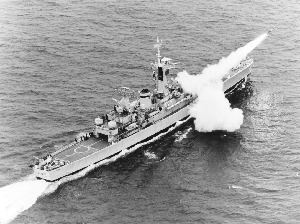Name HMS Phoebe (F42) Laid down 25 July 1963 Decommissioned 14 February 1991 Construction started 25 July 1963 Length 113 m | Commissioned 15 May 1966 Fate Sold for scrap 1992 Launched 19 December 1964 | |
 | ||
Builders Vickers-Armstrongs, Alexander Stephen and Sons | ||
HMS Phoebe (F42) was a Leander-class frigate of the Royal Navy (RN). She was, like the rest of her class, named after a figure of mythology. Built by Alexander Stephen and Sons on the River Clyde, she was launched on 19 December 1964 and commissioned on 15 May 1966.
Contents
Operational Service
In the year of her commission, Phoebe assisted in the emotionally charged withdrawal from Aden in 1967. In 1969, Phoebe took part in the 20th Anniversary of NATO Fleet Review held at Spithead.
In 1971, Phoebe deployed to the West Indies. That same year, Phoebe was guard ship during talks between UK Prime Minister Heath and U.S. President Nixon. In 1973, Phoebe took part in the Second Cod War, during the fishing disputes with Iceland.
Between 1973 and 1977 Phoebe was used for the filming of the popular Warship BBC drama, set on board the fictional HMS Hero.
In 1974, Phoebe commenced her modernisation, which including altering her weapons configuration. Her single 4.5-in twin turret was removed in favour of the Exocet anti-ship missile system, giving her a powerful anti-surface capability. The number of SeaCat missiles she carried was increased. The modernisation was completed in 1977. She subsequently took part in the Silver Jubilee celebrations and Fleet Review, at which many warships attended from a variety of nations.
During late 1977 and early 1978, Phoebe led a task force on active service to the South Atlantic (Falklands) in company with HMS Alacrity, HMS/m Dreadnought and RFA's Resurgent and Olwen calling at Funchal, Madeira before returning home.
In 1978, Phoebe patrolled in the Caribbean and subsequently joined Standing Naval Force Atlantic (STANAVFORLANT), a multi-national squadron of NATO in company with USS Pharris, FGS Emden, HMCS Okanagan and the Dutch frigate Tjerk Hiddes. In that year, Phoebe had the distinction of becoming the first frigate to operate the Westland Lynx attack helicopter aka 'Phelix', which remains in service, though obviously of a newer variant.
In September 1982, Phoebe deployed to the South Atlantic in the aftermath of the Falklands War, and performed a number of duties, though mainly patrolling in that region. In 1984, Phoebe completed her towed array sonar refit. In 1988, Phoebe again served under Standing Naval Force Atlantic and took part in the rescue effort in the tragic aftermath of the Piper Alpha oil rig explosion in the North Sea, which killed 167 people. Phoebe decommissioned in 1991 and was sold for scrap the following year.
